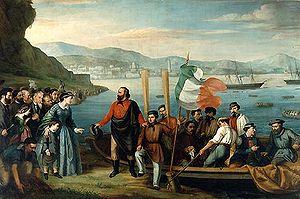Expedition of the thousand
| Expedition of the Thousand | |||||||||
|---|---|---|---|---|---|---|---|---|---|
| Part of the wars of Italian Unification | |||||||||
 The beginning of the expedition, to Sicily, at Quarto dei Mille, Genoa, northern Italy |
|||||||||
|
|||||||||
| Belligerents | |||||||||
|
Red Shirts |
|
||||||||
| Commanders and leaders | |||||||||
|
Victor Emmanuel II Giuseppe Garibaldi Enrico Cialdini |
Francis II Giosuè Ritucci Lukas von Mechel Pius IX Juchault de Lamoricière |
||||||||
Unification victory;
Collapse of the Two Sicilies;
Papal States reduced to Latium;
The Expedition of the Thousand (Italian Spedizione dei Mille) was an event of the Italian Risorgimento that took place in 1860. A corps of volunteers led by Giuseppe Garibaldi landed in Sicily in order to conquer the Kingdom of the Two Sicilies, ruled by the Bourbons.
The project was an ambitious and risky venture aiming to conquer, with a thousand men, a kingdom with a larger regular army and a more powerful navy. The expedition was a success and concluded with a plebiscite that brought Naples and Sicily into the Kingdom of Sardinia, the last territorial conquest before the creation of the Kingdom of Italy on 17 March 1861.
The sea venture was the only desired action that was jointly decided by the "four fathers of the nation" Giuseppe Mazzini, Giuseppe Garibaldi, Victor Emmanuel II, and Camillo Cavour, pursuing divergent goals. However, the Expedition was instigated by Francesco Crispi, who utilized his political influence to bolster the Italian unification project.
The various groups participated in the expedition for a variety of reasons: for Garibaldi, it was to achieve a united Italy; to the Sicilian bourgeoisie, an independent Sicily as part of the kingdom of Italy, and for the mass farmers, land distribution and the end of oppression.
The events of the Expedition took place within the overall process of the unification of Italy, which was largely orchestrated by Camillo Cavour, Prime Minister of Sardinia-Piedmont, as his life's work. After the annexation of the Grand Duchy of Tuscany, the Duchies of Modena and Parma and the Romagna to Piedmont in March 1860, Italian nationalists set their sights on the Kingdom of the Two Sicilies, which comprised all of southern mainland Italy and Sicily, as the next step toward their dream of unification of all Italian lands.
...
Wikipedia
